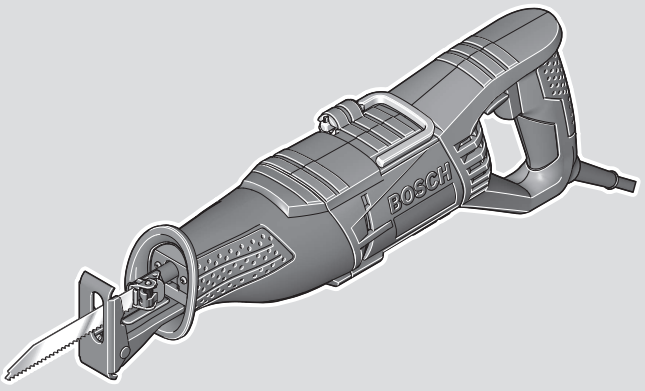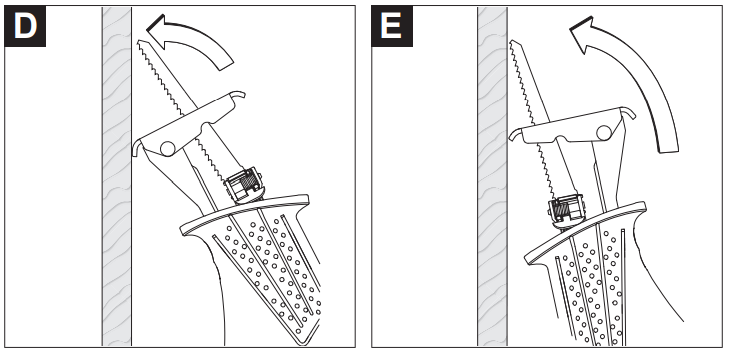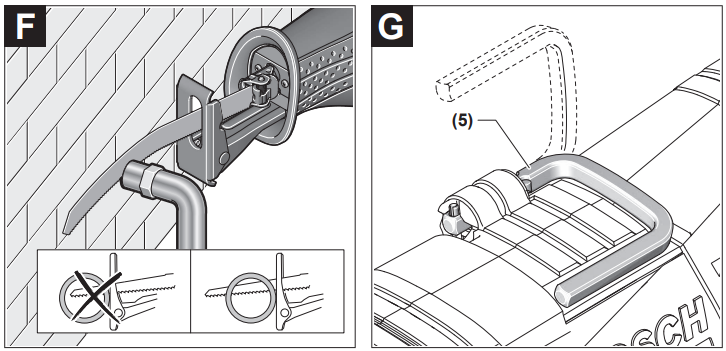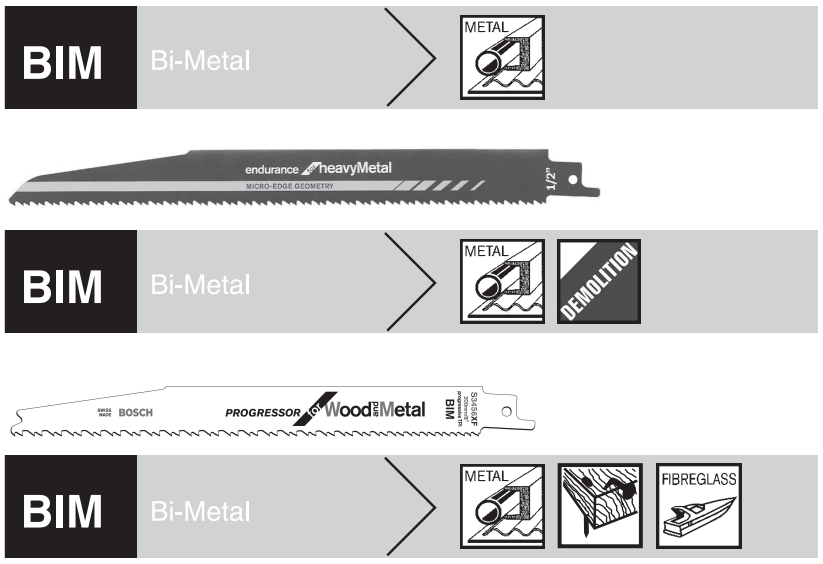 GSA 1100 E Professional
GSA 1100 E Professional


Original instructions





Safety instructions
General Power Tool Safety Warnings
![]() WARNING
WARNING
Read all safety warnings. instruct- tions, illustrations, and specifications provided with this power tool. Failure to follow all in instructions listed below may result in electric shock, fire, and/ Or serious injury.Save all warnings and instructions for future reference.The term ‘power tool’ in the warnings refers to your mains. operated (corded) power tool or battery. operated (cord. less) power tool.
Work area safety
- Keep work area clean and well-lit. Cluttered or dark areas invite
- Do not operate power tools in explosive atmospheres. such as in the presence of flammable liquids. gases or Power tools create sparks which may ignite the dust or fumes.
- Keep children and bystanders away while operating apower Distractions can cause you to lose control.
Electrical safety
- Power tool plugs must match the outlet. Never modify the plug in any way. Do not use any adapter plugs with earthed (grounded) power tools. Unmodified plugs and matching outlets will reduce the risk of electric shock.
- Avoid body contact with earthed or pounded sup faces, such as pipes, radiators, ranges, and refrigerat There is an increased risk of electric shock if your body is earthed or grounded.
- Do not expose power tools to rain or wet conditions. Water entering a power tool will increase the risk of electric shock.
- Do not abuse the cord. Never use the cord for carry pulling or unplugging the power tool. Keep cord away from heat. oil, sharp edges, or moving parts. Damaged or entangled cords increase the risk of electric shock.
- When operating a power tool outdoors, use an extension cord suitable for outdoor use. The use of a cord suitable for outdoor use reduces the risk of electric shock.
- If operating a power tool in a damp location is unavoidable, use a residual current device (RCD) protected supply. The use of an RCD reduces the risk of electric
Personal safety
- Stay alert, watch what you are doing, and use common sense when operating a power tool. Do not use a power tool while you are tired or under the influence of drugs, alcohol, or medication. A moment of anewtion while operating power tools may result in serious personal injury.
- Use personal protective equipment Always wear eye Protectiveequipment such asa dust mask. nonskid safety shoes. hard hat or hearing protection used for appropriate ccoditions will reducepersonal injuries.
- Prevent unintentional starting. Ensure the switch is in the off-position before connecting to a power source and/or battery pack, picking up or carrying the tool. Carrying power tools nth your finger on the switch or energising power tools that have the snitch on invites acci
- Remove any adjusting key or wrench before turning the power tool on A wrench or a key left attached to a rotating part of the power tool may result in personal in
- Do not overreach. Keep proper footing and balance at all This enables better control of the power tool in unexpected situations.
- Dress properly. Do not wear loose clothing or jew Keep your hair and clothing away from moving parts. Loose clothes. rosette’ y or long hair can be caught in! coxing parts.
- If devices are provided for the oomection of dust extraction and collection facilities, ensure these are connected and properly used. The use of dust collection can reduce dust-related hazards
- Do not let familiarity gained from frequent use of tools allow you to become complacent and ignore tool safety principles. A careless action can cause severe injury within a fraction of a second.
Power tool use and care
- Do not force the power tool. Use the correct power tool for your application. The correct power tool will do the lob better and safer at the rate for Much it was signed.
- Do not use the power tool if the switch does not turn on and off. Any power tool that cannot be controlled nth the switch is dangerous and must be repaired.
- Disconnect the plug from the power source and/or remove the battery pack, if detachable, from the power tool before making any adjustments, changing acCeSSOrieS, or storing power Such preventive safety measures reduce the risk of starting the power tool accidentally.
- Store idle power tools out of the reach of children and do not allow persons unfamiliar with the power tool or these instructions to operate the power tool. Power tools are dangerous in the hands of untrained users.
- Maintain power tools and accessories. Check for misalignment or binding of moving parts, breakage of parts, and any other condition that may affect the power tool’s operation. If damaged, have the power tool repaired before use. Many accidents are caused by poorly maintained power tools.
- Keep cutting tools sharp and dean. Properly mall. tamed cutting tools with sharp cutting edges are less likely to be a bird and are easier to control.
- Use the power tool, accessories and tool bits, etc. in accordance with these instructions, taking into ac- count the working conditions and the work to be per-Use of the power tool for operations different from those intended could result in a hazardous situation.
- Keep handles and grasping surfaces dry, clean, and free from oil and grease. Slippery handles and grasp ng surfaces do not allow for safe handling and control of the tool in unexpected situations.
Service
- Have your power tool serviced by a qualified repair person using only identical replacement parts. This will ensure that the safety of the power tool is maintained.
Safety instructions for reciprocating saws
- Hold the power tool by insulated gripping surfaces, when performing an operation where the cutting accessory may contact hidden wiring or its own cord. Cutting accessory contacting a live’ wire may make exposed metal parts of the power tool live’ and could give the operator an electric
- Use damps or another practical way to secure and support the workpiece to a stable platform. Holding the workpiece by hand or against your body leaves it unstable and may lead to loss of control.
- Keep hands away from the sawing area Do not reach under the workpiece. Contact with the saw blade can lead to
- Hold the power tool firmly with both hands and make sure you have a stable footing. The power tool can be more securely guided with both hands.
- Only king the power tool into contact with the workpiece when switched on. Otherwise, there is a danger of kickback if the cutting tool jams in the workpiece.
- Ensure that the footplate is always resting on the workpiece while sawing. The saw blade can jam and lead to loss of control over the power tool.
- When the cut is completed. switch off the power tool and then pull the saw blade out of the cot only after it has come to a standstill. In this manner, you can avoid kickback and can place down the power tool
- Always wait wit/ the power tool has come to a complete stop before placing it down. the application tool can jam and cause you to lose control of the power tool.
- Use only undamaged saw blades that are in perfect Bent or dull saw blades can break. negatively influence the cut. or lead to kickback.
- Do not break the saw blade to a stop by applying side pressure after switching off. The saw blade can be darn. break or cause kickback.
- Ensure that the material is securely clamped. Do not support the workpiece using your hands or feet. Do not touch any objects or the floor with the saw while it is running. There is a risk of kickback.
- Use suitable detectors to determine if utility lines are hidden in the work area or call the local utility company for assistance. Contact with electric lines can lead to fire and electric shock. Damaging a gas line can lead to an explosion. Penetrating a water line causes property damage or may cause an electric shock.
Products sold in GB only:
Your product is fitted with a BS 1363/A approved electric plug with an internal fuse (ASTA approved to BS 1362).if the plug is not suitable for your socket outlets, it should be cut off and an appropriate plug fitted in its place by an authorised customer service agent. The replacement plug should have the same fuse rating as the original plug.The severed plug must be disposed of to avoid a possible shock hazard and should never be inserted into a mains socket elsewhere.
Product Description and Specifications
 Read all the safety and general instructions.Failure to observe the safety and general instructions may result in electric shock, fire, and/or serious injury.Please observe the illustrations at the beginning of this operating manual.
Read all the safety and general instructions.Failure to observe the safety and general instructions may result in electric shock, fire, and/or serious injury.Please observe the illustrations at the beginning of this operating manual.
Intended Use
The power tool is suitable for sawing wood, plastic, metal, and building materials on a firm surface. It is suitable for straight and curved cuts. When using designated suitable bimetal saw blades, flush cutting is also possible. The saw blade recommendations are to be observed.
Product features
The numbering of the product features refers to the diagram of the power tool on the graphics page.
(1) Sawblade A)(2) Adjustable base plate(3) Saw blade receptacle(4) SDS lever for saw blade release(5) Utility hook(6) Lock-off button for on/off switch (3 601 F4C 84.)(7) On/off switch(8) Hex key(9) Worklight(10) Handle (insulated gripping surface)(11) Clamping plate(12) Baseplate screw
A) Accessories shown or described are not included with the product as standard. You can find the complete selection of accessories in our accessories range.
Technical data
| Reciprocating saw Article | GSA 1100 E | |
| number | 3 601F4C 8. | |
| Stroke rate control | • | |
| Rated power input | W | 1100 |
| No•load stroke rate no | min’ | 0-2700 |
| Tool holder | SDS | |
| Stroke | mm | 28 |
| Max. cutting depth | ||
| – in wood | mm | 230 |
| – in steel (unalloyed) | mm | 20 |
| – Pipe diameter | mm | 150 |
| Weight according to EPTAProcedure 01:2014 | kg | 3.6 |
| Protection class |
The specifications apply to a rated voltage [U] of 230 V. These specifications may vary at different voltages and in country-specific models.
Assembly
- Pull the plug out of the socket before carrying out any work on the power tool.
Inserting/changing the saw blade
- When fitting or changing the saw blade, wear protective gloves. Blades are sharp and can become hot when used for prolonged periods of time.
- While replacing the saw blade, ensure that the saw blade receptacle is free of material residue, e.g. wood or metal chips.
Selecting the saw bladeYou will find an overview of recommended saw blades at the end of these operating instructions. Only use saw blades with a 1/2″ universal shank. The saw blade should not be longer than required for the intended cut.Inserting the saw blade (see figure A)Press the SDS lever (4) forward and guide the saw blade (1) behind the clamping plate (11) into the saw blade receptacle (3). Release the SDS lever (4).
- Check that it is seated securely by pulling the saw blade. A loose saw blade can fall out and lead to injuries. For particular jobs, the saw blade (1) can also be flipped 180° (teeth point upwards) and refitted.
Removing the saw blade
- Let the saw blade cool down before removing it. There is a risk of injury when touching the hot saw blade. Press the SDS lever (4) forward and pull out the saw blade (1). Release the SDS lever (4).
Dust/Chip Extraction
Dust from materials such as lead-containing coatings, some wood types, minerals, and metal can be harmful to one’s health. Touching or breathing in the dust can cause allergic reactions and/or lead to respiratory infections of the user or bystanders.Certain dust, such as oak or beech dust, is considered carcinogenic, especially in connection with wood-treatment additives (chromate, wood preservative). Materials containing asbestos may only be worked by specialists.–Provide for good ventilation of the working place.– It is recommended to wear a P2 filter-class respirator.Observe the relevant regulations in your country for the materials to be worked.
- Avoid dust accumulation at the workplace. Dust can easily ignite.
Operation
- Products that are only sold in AUS and NZ: Use a residual current device (RCD) with a nominal residual current of 30 mA or less.
Starting Operation
- Pay attention to the mains voltage. The voltage of the power source must match the voltage specified on the rating plate of the power tool. Power tools marked with 230 V can also be operated with 220 V.
WorklightThe work light (9) lights up when connected to the mains power and improves visibility in the immediate work area.
- Do not look directly into the work light; it can blind you.
Switching On and Off (3 601 F4C 84.)To switch on the power tool, press the lock-off switch (6) first. Then press the on/off switch (7) and keep it pressed. To switch off the power tool, release the on/off switch (7). Note: For safety reasons, the on/off switch (7) cannot be locked; it must remain pressed during the entire operation.Switching On and Off (3 601 F4C 85., 3 601 F4C 88., 3 601 F4C 8B., 3 601 F4C 8K., 3 601 F4C 8L.)To switch on the power tool, press the on/off switch (7) and keep it pressed.To switch off the power tool, release the on/off switch (7). Note: For safety reasons, the on/off switch (7) cannot be locked; it must remain pressed during the entire operation.Controlling the stroke rateYou can variably adjust the stroke rate of the power tool when it is on by pressing in the on/off switch (7) to varying extents.Applying light pressure to the on/off switch (7) results in a low stroke rate. Applying increasing pressure to the switch increases the stroke rate.The required stroke rate is dependent on the material and the work conditions and can be determined using practice tests.It is recommended that you reduce the stroke rate when placing the saw blade on the workpiece and when sawing plastic and aluminum.During prolonged periods of use at a low stroke rate, the power tool may heat up significantly. Remove the saw blade and let the power tool run at the maximum stroke rate for around three minutes to cool down.
Working Advice
- Pull the plug out of the socket before carrying out any work on the power tool.
- Switch the power tool off immediately if the saw blade becomes blocked.
Tips
- When sawing lightweight materials, take into account the statutory provisions and recommendations of the material manufacturers.
Before sawing into the wood, chipboard, building materials, etc., check for any foreign objects such as nails, screws, etc. and use a suitable saw blade.Switch on the power tool and guide it towards the workpiece you wish to work on. Place the base plate (2) on the surface of the workpiece and saw through the material applying even pressure and feed. Switch the power tool off once you have finished your work.Switch the power tool off immediately if the saw blade jams. Widen the sawing gap slightly with a suitable tool and pull the power tool out.
Swiveling and removable base plate (see figures B−C)
Thanks to its mobility, the base plate (2) adopt the required angle position of the surface.Depending on the application and the saw blade being used, the base plate (2) can be moved continuously in the length direction to differentsettings.Loosen the screws (12) with the hex key (8) and slide the base plate (2) into the desired position. Re-tighten the screws and check whether the base plate is fixed in place.
Plunge cutting (see figures D–E)
- Plunge cuts may only be applied to soft materials, such as wood, gypsum board, etc. Do not plunge cut metal materials.
For plunge cutting, use only short saw blades.Place the power tool so that the edge of the base plate (2) rests on the workpiece, without the saw blade (1) touching the workpiece, and switch it on. When using power tools with stroke rate control, select the maximum stroke rate.Press the power tool firmly against the workpiece and allow the saw blade to plunge slowly into the workpiece.As soon as the base plate (2) rests fully on the workpiece, continue sawing along the required cutting line.
For particular jobs, the saw blade (1) can also be fitted after being turned 180° in order to operate the power tool the other way around.
Flush sawing (see figure F)Protruding components such as water pipes, for example, can be cut directly at the wall using elastic bi-metal saw blades.
- Ensure that the saw blade is always longer than the diameter of the workpiece. There is a risk of kickback.
Place the saw blade directly against the wall and bend it slightly by applying lateral pressure to the power tool until the base plate is flush with the wall. Switch on the power tool and saw through the workpiece applying consistent lateral pressure.
Utility hook (see figure G)Your power tool is equipped with a utility hook (5) for hanging it, e. g., from a ladder. Simply fold out the utility hook to the required position.
- When the power tool is hung up, take care that the saw blade is protected from accidental contact. saw blade is protected from accidental contact. This poses a risk of injury.
Fold the utility hook (5) in again when you want to begin work with the power tool.
Coolant/lubricant
As the material heats up along the cutting line when cutting metal, you should apply coolant or lubricant.
Maintenance and Service
Maintenance and Cleaning
- Pull the plug out of the socket before carrying out any work on the power tool.
- To ensure safe and efficient operation, always keep the power tool and the ventilation slots clean.
In order to avoid safety hazards, if the power supply cord needs to be replaced, this must be done by Bosch or by an after-sales service center that is authorized to repair Bosch power tools.Carefully clean the saw blade receptacle with a soft cloth. To do so, remove the saw blade from the power tool. Keep the saw blade receptacle operational using suitable lubricants.If the power tool becomes very dirty, this can lead to serious faults. For this reason, do not cut materials that generate large quantities of dust from below or overhead.
After-Sales Service and Application Service
Our after-sales service responds to your questions concerning maintenance and repair of your product as well as spare parts. You can find explosion drawings and information on spare parts at: www.bosch-pt.comThe Bosch product use advice team will be happy to help you with any questions about our products and their accessories.
In all correspondence and spare parts orders, please always include the 10‑digit article number given on the nameplate of the product.
MalaysiaRobert Bosch Sdn. Bhd.(220975-V) PT/SMYNo. 8A, Jalan 13/646200 Petaling JayaSelangorTel.: (03) 79663194Toll-Free: 1800 880188Fax: (03) 79583838E-Mail: [email protected]www.bosch-pt.com.my
You can find further service addresses at:www.bosch-pt.com/serviceaddresses
Disposal
![]() Do not dispose of power tools along with the household waste.
Do not dispose of power tools along with the household waste.


1 609 92A 5P6 | (14.09.2020)Bosch Power Tools
References
Dịch vụ đăng ký bảo hành linh kiện Bosch, phụ tùng Bosch, máy khoan Bosch
Service worldwide
首页
Bosch Power Tools | Bosch Power Tools
Invented for life | Bosch Global
บ๊อช ประเทศไทย | บ๊อช ประเทศไทย
Bosch Power Tools | Bosch Power Tools
📧[email protected]
📧[email protected]
Trang chủ
📧[email protected]
📧[email protected]
Select your country | Bosch Power Tools
Bosch Power Tools | Bosch Power Tools
[xyz-ips snippet=”download-snippet”]


